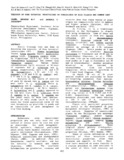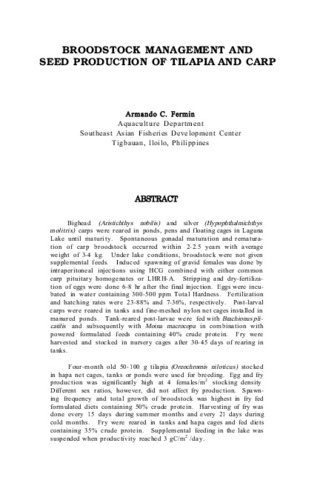Toxicity of four botanical insecticides to fingerlings of Nile tilapia and common carp
- Global styles
- MLA
- Vancouver
- Elsevier - Harvard
- APA
- Help

View/
Date
1994Page views
2,531AGROVOC keyword
Taxonomic term
Metadata
Perlihat publikasi penuh
Share
Abstract
Static bioassay test was done to determine the toxicity of four botanical insecticides (BI) - Blumea balsamifera leaves, Vitex negundo leaces, Azadirachta indica seeds, Tinospora rumphii stems to fingerlings (0.8 - 1.5g) nile tilapia (Oreochromis niloticus) and common carp (Cyprinus carpio). Median lethal concentration (g/1) obtained at 96 - hour of exposure for O. niloticus and C. carpio, respectively, were 1.54 and 137 (B. balsamifera), 4.95 and 3.53 (V. negundo), 1.59 and 0.55 (A.indica), and, 0.77 and 2.13 (T. rumphii).
Analysis on the levels of toxicity of each BI showed that A. indica was the most toxic to O. niloticus to C. carpio, at 24 - h of exposure. At 96 - h, however, B. balsamifera and T. rumphii appeared to be the most toxic to O. niloticus while T. rumphii to C. carpio. V. negundo was the least toxic to both test species. Results of this study could be used as basis for field application rates of the test botanicals as piscicide in ponds and as insecticide in pest management rice-fish farming.
Type
Conference paperKoleksi
- Conference Proceedings [299]
Related items
Showing items related by title, author, creator and subject.
-
Polyculture of bighead carp, common carp and Nile tilapia in cages in Laguna lake
Tabbu, Marlo Y.; Lijauco, Melchor M.; Eguia, Ruel V.; Espegadera, Corazon C. (Fisheries Research Society of the Philippines, 1986)Increasing fish production through polyculture was clearly demonstrated to the fishfarmers in Laguna lake. The rearing of different species of fish of proper number and species combinations had resulted to the efficient ... -
Demonstration of tilapia-carp polyculture in lowland and highland farms
Palma, Adelaida L.; Pol, Romy M.; Diamante, Adan Samuel (Bureau of Agricultural Research, Department of Agriculture, 2007)Technology demonstration was conducted in three selected lowland freshwater ponds in Lucban, Quezon and in three highland ponds in Ifugao. The ponds varied in location, size, water source, and operators. The polyculture ... -
Broodstock management and seed production of tilapia and carp
Fermin, Armando C. (Aquaculture Department, Southeast Asian Fisheries Development Center, 1988)Bighead (Aristichthys nobilis) and silver (Hypophthalmichthys molitrix) carps were reared in ponds, pens and floating cages in Laguna Lake until maturity. Spontaneous gonadal maturation and rematuration of carp broodstock ...




